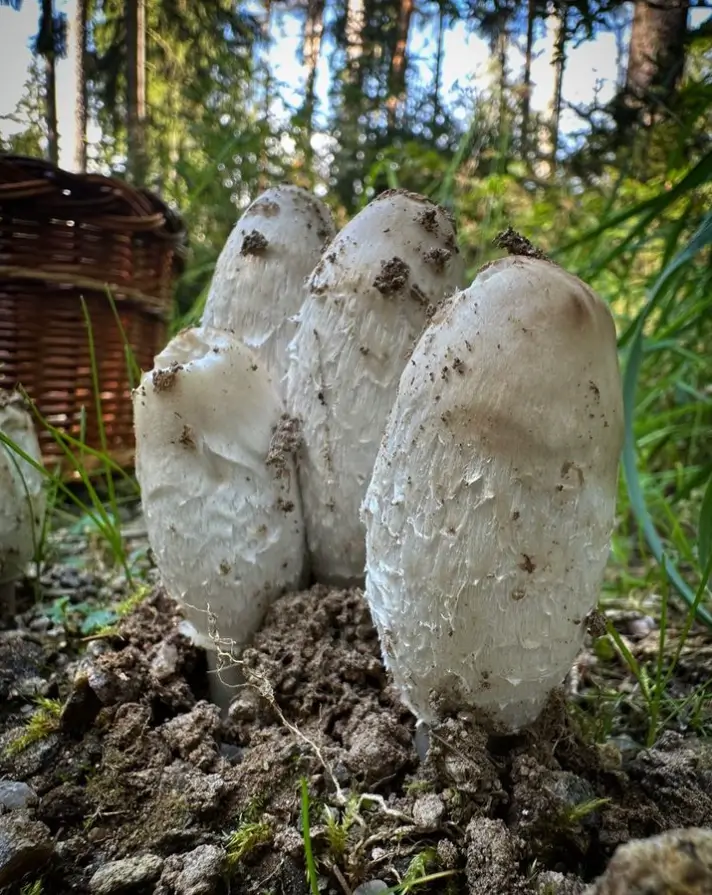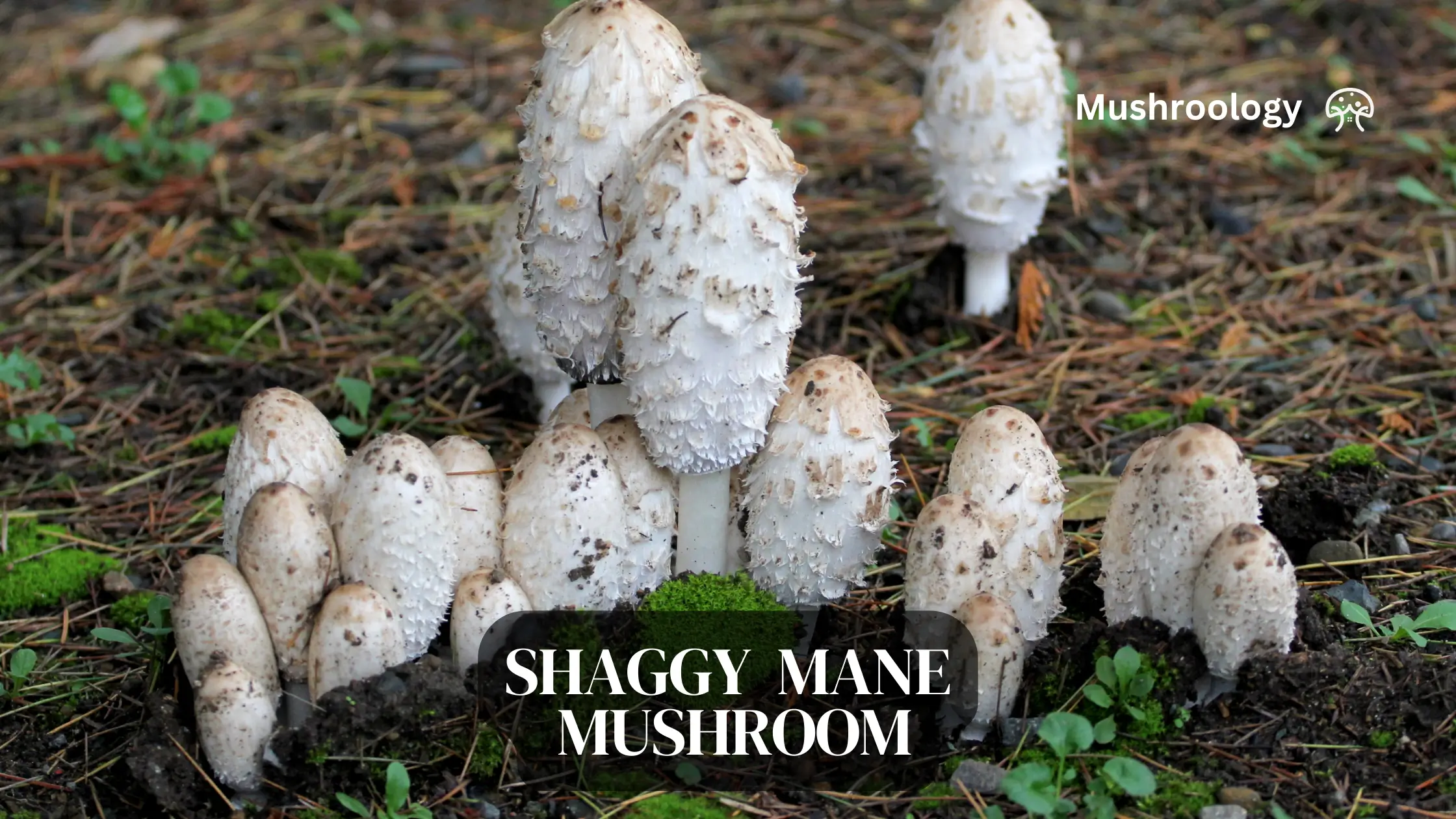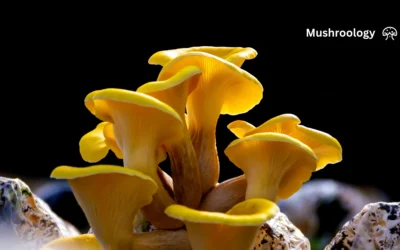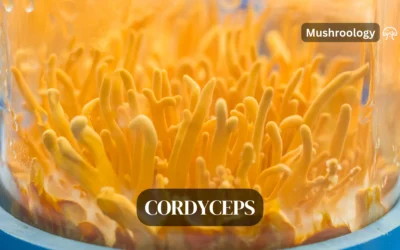Shaggy Mane mushrooms (Coprinus comatus), also known as Lawyer’s Wig or Ink Cap, are fascinating fungi that offer both unique growing challenges and delicious rewards. With their distinctive shaggy white caps that eventually dissolve into black ink, these mushrooms are not only a culinary delight but also an interesting addition to any home cultivation project.
One of the most intriguing aspects of Shaggy Manes is their self-digestion process, called autodigestion or deliquescence. After the mushroom’s spores mature, the cap begins to digest itself from the bottom up, turning into a black, inky substance. This process happens quickly—often within hours—giving these mushrooms an unusually short shelf life after they mature. Historically, this “ink” was even used for writing!
Are Shaggy Mane mushrooms edible?
Shaggy mane mushrooms, or lawyer wig mushroom, are edible when young and still firm, and are considered a gourmet mushroom with a mild, earthy flavor and delicate texture. They must be harvested promptly before the autodigestion process (autolysis) begins, as older mushrooms liquefy into an inedible black goo.
Key points regarding their edibility include:
- Harvest shaggy mane mushrooms while they are young, white, and firm. Once they begin autodigestion (turning into black ink-like liquid), they are no longer suitable for consumption.
- Due to their rapid decomposition, shaggy manes should be cooked or processed within a few hours of harvesting. They can be sautéed, simmered, or flash-frozen after cooking to preserve them longer. Drying is not effective due to their high water content.
- Shaggy mane mushrooms have a subtle yet distinctive earthy flavor. As they age and begin autodigestion, their flavor intensifies; some chefs use this stage creatively, but it’s generally safer for home cultivators to consume them when young.
- Shaggy mane mushrooms contain compounds that interfere with alcohol metabolism. It is advisable to avoid alcohol consumption for up to 48 hours after eating these mushrooms to prevent unpleasant reactions.
- While relatively easy to identify due to their distinct characteristics (white cylindrical shape with shaggy scales turning into black ink), caution is necessary to avoid confusion with similar-looking toxic species like Coprinopsis atramentaria.

What makes Shaggy Mane mushrooms special
Shaggy Manes are easily identified by their:
- Tall, cylindrical white caps covered with shaggy scales (1-6 cm in diameter)
- White stems that can reach 4-6 inches in height
- Gills that start white, turn pink, and finally black as they mature
- Unique self-digesting process that turns the mushroom into black ink
In the wild, they typically grow in:
- Grassy areas like lawns, meadows, and parks
- Nitrogen-rich environments
- Disturbed soils and compost heaps
- Areas with accumulated organic waste
Studies have shown that in optimal conditions, you might find 30-50 mushrooms growing per square meter in suburban lawns!
Shaggy Mane’s life cycle
Understanding how Shaggy Manes grow is key to successful cultivation:
- Spore germination: Spores land on suitable substrate and begin growing
- Mycelium growth: Thread-like cells spread through the growing medium
- Fruiting body formation: When conditions are right, mushrooms begin to form
- Maturation: Caps elongate and develop their characteristic shaggy appearance
- Spore release and autodigestion: The cap liquefies from the bottom up, releasing spores
- Decomposition: The mushroom returns nutrients to the soil
Research has found that Shaggy Manes often fruit after rainfall followed by a temperature drop of 5-10°C, which is helpful to know when planning outdoor cultivation.
Getting started: what you’ll need to grow Shaggy Mane
Basic requirements
Successful Shaggy Mane cultivation requires:
- Temperature: 50-68°F (10-20°C) for fruiting; 65-75°F (18-24°C) for spawn run
- Humidity: 40-60% for fruiting; 60-70% during colonization
- Light: Indirect natural light or artificial lighting (8-12 hours daily)
- Air circulation: Moderate air exchange to prevent CO₂ buildup
- Substrate: Organic material with proper nutrition (more on this below)
- Patience: These mushrooms follow their own timeline!
Equipment for Beginners
If you’re just starting out, here’s what you’ll need:
- Spray bottle for misting
- Humidity gauge (hygrometer)
- Thermometer
- Clean containers for growing
- Shaggy Mane spawn or grow kit
- Substrate materials (based on your chosen method)
Cultivation Methods
Method 1: Using a commercial grow Kit
For beginners, a grow kit is the easiest way to start:
- Setting up your kit:
- Place in a clean area with indirect light
- Keep temperature between 50-68°F (10-20°C)
- Avoid heating vents and direct sunlight
- Maintaining your kit:
- Mist the inside of the grow bag 1-2 times daily
- Monitor humidity levels (aim for 40-60%)
- Ensure proper air exchange by briefly opening the bag
- What to expect:
- Mycelium will colonize the substrate (appears as white, thread-like growth)
- Small “pinheads” will form
- Mushrooms will grow quickly once started
- Kit should produce 2-3 flushes (harvests) with proper care
Method 2: Indoor DIY substrate method
For more control over your grow, try creating your own substrate:
- Materials needed:
- Shaggy Mane spawn (liquid culture or grain spawn)
- Substrate materials (options below)
- Containers or bags for growing
- Equipment for pasteurization
- Spray bottle and monitoring tools
- Effective substrate options: Traditional straw-manure mix:
- 50% horse or cow manure mixed with 50% straw or hardwood chips
- Creates an ideal C:N ratio of 25:1 to 30:1
- Requires 5-day composting cycle for best results
- Corn cobs (94%) with 1% urea and 3% lime
- Maintains pH at 8.0-9.0
- Works well in bag culture systems
- Spent Agaricus (button mushroom) substrate
- Add 25% cottonseed hulls and 3.5% calcium carbonate
- Achieves 70% of the yield compared to fresh substrate
- Light blue pulp paper waste with 10% rice bran
- Studies show 23.96% biological efficiency
- Environmentally friendly option
- 68% sawdust, 18% wheat bran, 3% soybean meal, 1% calcium carbonate
- Good for bag cultivation
- Requires 20-day colonization at 23°C
- Substrate preparation:
- Pasteurize your chosen substrate (160-170°F or 70-75°C for 1-2 hours)
- Cool to room temperature before use
- Mix with spawn at 10-20% ratio (more spawn = faster colonization)
- Growing process:
- Pack substrate into sterilized containers
- Allow 3-8 weeks for complete colonization
- Maintain 60-70% moisture in substrate during this phase
- Once fully colonized (substrate appears white), introduce fruiting conditions
- Lower temperature to 50-68°F (10-20°C)
- Increase humidity to 85-90%
- Introduce indirect light
- Watch for mushroom formation
Method 3: Outdoor bed cultivation
Growing outdoors can produce larger harvests with less maintenance:
- Choosing a location:
- Partial shade area with good drainage
- Protection from strong winds
- Easy access to water
- Loamy soil is ideal
- Bed preparation:
- Create a 1m² plot with 30cm depth
- Avoid areas with previous mushroom diseases
- Prepare in spring or fall when soil temperatures are 50-65°F (10-18°C)
- Layered inoculation method:
- Alternate 5cm substrate layers with grain spawn (10-15% inoculation rate)
- Finish with 5cm of peat moss casing
- Install shade cloth (60-70% density) for temperature control
- Set up irrigation to maintain moisture (about 0.5L/m²/day)
- Lawn integration:
- Aerate lawn to create openings
- Mix spawn with compost
- Work mixture into aeration holes or spread thinly
- Water thoroughly
- Expect mushrooms in 6-12 months
- Natural fruiting typically occurs in spring and fall
How to preserve freshly harvested shaggy mane mushrooms:
- Drying/Dehydrating: Slice shaggy manes about 3/8 inch thick and dehydrate in a food dehydrator or other warm, well-ventilated area. This method causes some loss of flavour but allows long-term storage.
- Pickling: Use standard pickling recipes and techniques to pickle whole, small, shaggy manes or halves/quarters of larger ones. Pickling alters the mushrooms’ natural flavor.
- Freezing: Blanch raw shaggy manes briefly in boiling water, chill in ice water, drain, and freeze in airtight bags from which air has been squeezed out. It is best used later in soups or sauces as the texture changes with freezing.
- Sauteing then Freezing: Saute fresh shaggy manes into a skillet until the liquid evaporates. Cool completely, then freeze sauteed mushrooms in single portions. Said to preserve delicate flavour best.
- Refrigerating in Water: Place fresh shaggy manes in cold water in a sealed container in the fridge to slow deterioration. Works for 1-2 days.
Troubleshooting common problems when growing your Shaggy Mane mushrooms
Contamination issues
- Signs of contamination:
- Green or blue mold growth
- Sour or unpleasant odors
- Unusual colors or textures
- Lack of mycelium growth
- Prevention:
- Maintain clean work environment
- Use proper pasteurization techniques
- Practice good hand hygiene
- Use sterile tools
- What to do if contamination occurs:
- Isolate contaminated containers
- Remove small contaminated sections if possible
- If widespread, dispose of entire batch safely
- Clean growing area thoroughly before starting again
Growing problems
- Poor mycelium development:
- Possible causes: temperature fluctuations, improper moisture, contamination
- Solutions: stabilize environment, check humidity, ensure quality spawn
- No mushroom formation:
- Possible causes: insufficient light, improper temperature shock, improper watering
- Solutions: introduce light cycle, create temperature differential, adjust watering
- Small or deformed mushrooms:
- Possible causes: insufficient nutrients, excessive CO₂, improper humidity
- Solutions: supplement substrate, improve air exchange, adjust humidity
- Specific issues identified in research:
- “Leggy” stipes: Caused by excessive CO₂ or insufficient light—fixed by improving air flow or increasing light exposure
- Stipe base necrosis: Results from calcium deficiencies—addressed with gypsum amendments (3kg/m³)
- Premature deliquescence: Can be managed by quick-cooling harvested mushrooms to 4°C
Advanced techniques for experienced growers
Spawn Production
Creating your own spawn allows for more control and cost savings:
- Tissue culture method:
- Select healthy, young mushroom
- Take tissue sample from inner stem using sterile technique
- Transfer to agar medium
- Isolate and propagate strong mycelium
- Spore collection:
- Allow cap to begin autodigestion
- Collect liquid in sterile container
- Use fresh for spore slurry or dry for storage
Experimental substrates for Shaggy Mane mushrooms
Try these innovative growing mediums:
- Coffee grounds method:
- Collect used coffee grounds
- Pasteurize at 160-170°F (70-75°C) for 1-2 hours
- Mix with 10-20% spawn
- Colonize and fruit as normal
- Cardboard cultivation:
- Soak corrugated cardboard in hot water
- Layer with spawn between corrugations
- Stack in container with high humidity
- Monitor for colonization and fruiting
- LED spectral tuning:
- Recent research suggests specific light wavelengths can improve yields
- Blue spectrum (450-495 nm) may enhance primordial formation
- Experiment with different light sources and duration
With their unique appearance and appealing flavor, Shaggy Mane mushrooms can be easily grown at home. Just maintain the ideal humidity, temperatures, and substrate conditions to produce a successful mushroom harvest!
FAQ
What is the ideal temperature for fruiting Shaggy Mane mushrooms?
The ideal temperature range for fruiting Shaggy Mane mushrooms is 50-68°F (10-20°C).
What level of humidity is best for Shaggy Manes to grow properly?
Shaggy Manes grow best at a humidity level of 40-60%.
How long does it take for Shaggy Mane spawn to fully colonize the mushroom substrate?
It takes approximately 3-8 weeks for Shaggy Mane mushroom spawn to fully colonize the substrate.
Can Shaggy Mane mushrooms be grown in direct sunlight?
No, Shaggy Manes require indirect natural light or artificial lighting. Direct sunlight can dry out the mushrooms.
What depth should the Shaggy Mane mushroom substrate layer be?
The substrate layer should be 2-4 inches (5-10 cm) thick to grow Shaggy Mane mushrooms.
What is the average yield per flush when cultivating Shaggy Manes? When growing Shaggy Manes, expect approximately 0.25-1 lb (100-500 grams) fresh weight per flush.
How often should humidity levels be checked when fruiting Shaggy Manes?
Check humidity levels 1-2 times daily when fruiting Shaggy Mane mushrooms.
Does growing Shaggy Mane mushrooms require any special equipment?
Basic home growing requires no special equipment beyond a humidity gauge/hygrometer.
Is it possible to reuse spent Shaggy Mane substrate?
Yes, Shaggy Mane substrate can produce around 2-3 flushes over 6-8 weeks before needing replacement.
What types of materials can be used as a substrate for cultivating Shaggy Manes?
Straw, sawdust, wood chips, and composted grass clippings can all be used.





